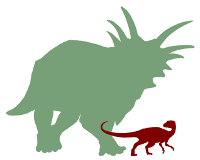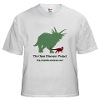In a recent post, we gave an introduction to the osteology of the forelimb. Now, we’ll round out that series with a consideration of the hind limb. Fortunately, many of the concepts are the same, so we’ll be able to move more quickly.
As you may recall, the forelimb was divided into a pectoral girdle, a big proximal bone (the humerus), two more distal long bones (radius and ulna), and a hand (manus) consisting of some carpals, metacarpals, and phalanges (with some modified into unguals). The same pattern follows for the hind limb, with a pelvic girdle, a big proximal bone (the femur), two more distal long bones (tibia and fibula), and a foot (pes) consisting of some tarsals, metatarsals, and phalanges (again, with some modified into unguals). Easy, isn’t it?
First, let’s take a look at the pelvic girdle. In dinosaurs, as in humans and pretty much every other limbed vertebrate, the pelvis includes three elements on each side: ilium, pubis, and ischium. Looking at the whole structure in side view, the ilium is the top bone, and the latter two are on the bottom. Where the three bones meet, their surfaces form the limb socket, which is called the acetabulum. The ilium is a pretty big, usually flat structure, that anchors the pelvis (and thus the limb) to the vertebral column. Lots of thigh and butt muscles also attach to it. Of the two bottom bones, the pubis is the front (anterior, sometimes called cranial) one. A big deal has been made of its difference in its orientation between ornithischian and saurischian dinosaurs – in ornithischians, most of the bone is directed backwards, and in most saurischians (with the exception of birds and their close allies) the bone is directed forwards. Finally, there is the ischium (which a classically-grounded anatomy professor of mine liked to note is correctly pronounced with a hard “k” sound, rather than the “ish-ee-um” that most folks use). For various reasons (namely, all of the processes and extra bumps render accurate comparison of measurements difficult), we won’t be doing much with the pelvis in the present study. So, let’s move on to the femur.
The femur, just like the humerus, is a single robust bone that articulates with the limb girdle, its head fitting into the acetabulum proximally, and with two other elements distally. Sometimes, there is a little backwards-directed hangy process from the middle of the shaft, called the fourth trochanter.
The tibia and fibula are the developmental homologues of the forelimb’s radius and ulna. Unlike mammals, dinosaurs lack a kneecap (patella) floating over the proximal end of the tibia and distal end of the femur.
The “foot” is called the pes (Latin for “foot”), and is very slightly differently configured than for the manus. The hind limb’s equivalent of carpals are called tarsals – and unlike the condition up front, the tarsals are actually rather important and frequently ossified elements. In fact, they are so ossified that they usually fuse right on to the tibia and / or fibula. The two major tarsals in ornithischians are the astragalus (capping the tibia) and the calcaneum (capping the fibula, or at least floating in its general vicinity). Because the astragalus is so often fused to the tibia, many authors measure tibia length with the astragalus included.
Instead of metacarpals, we now have metatarsals. The numbering system is the same as for the manus, except they’re abbreviated as “MT.” So, the first (innermost) metatarsal, equivalent to the one associated with our big toe, is MT-I. Phalanges are handled quite similarly, with IV-2 being the second most proximal phalanx on the fourth digit. And once again, the final phalanges are often modified into unguals.
And that’s all there is to know about ornithischian dinosaur limb osteology!





Excellent. Going right into the ppt for tomorrow!
Oh Andy, there’s SO MUCH MORE to know about ornithischian limb osteology…
Is someone volunteering for a guest post?